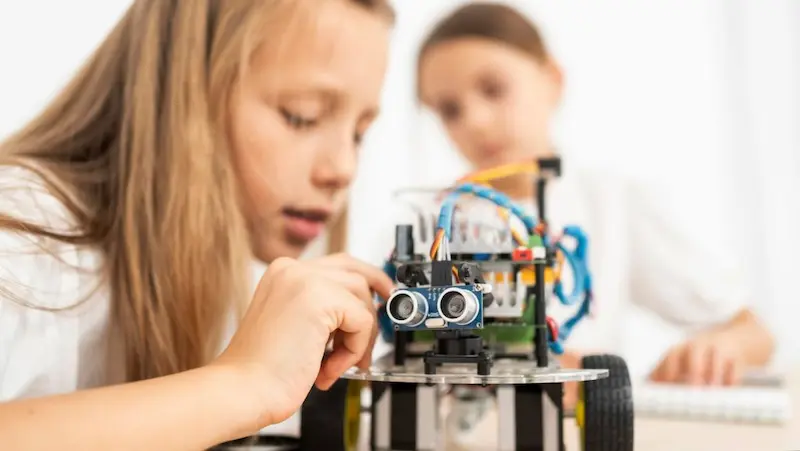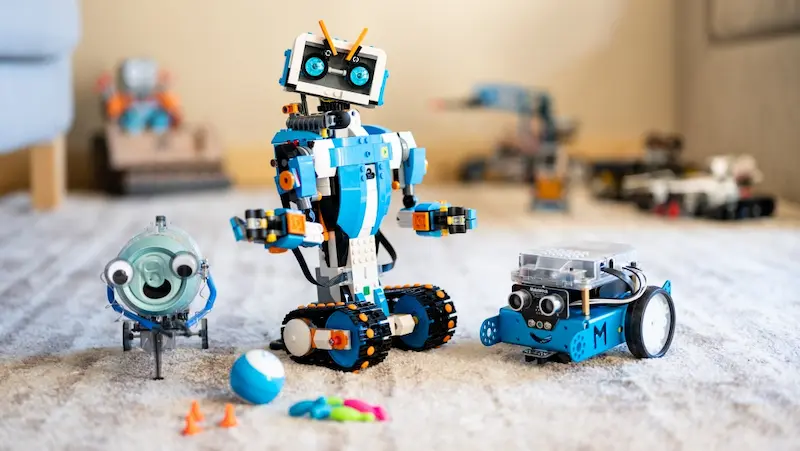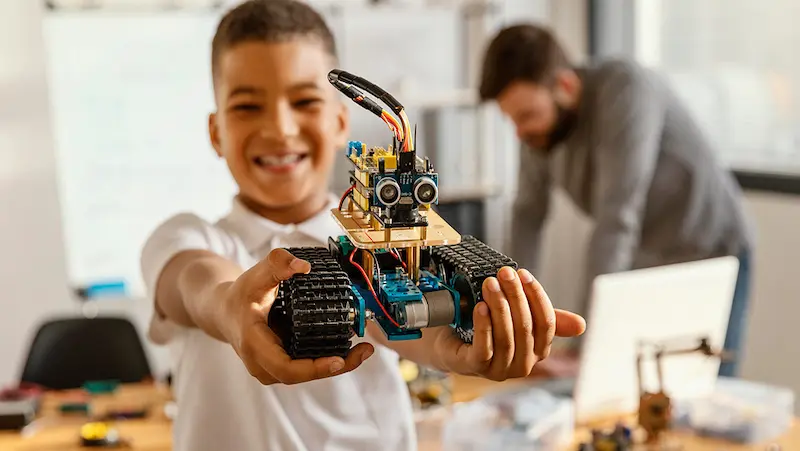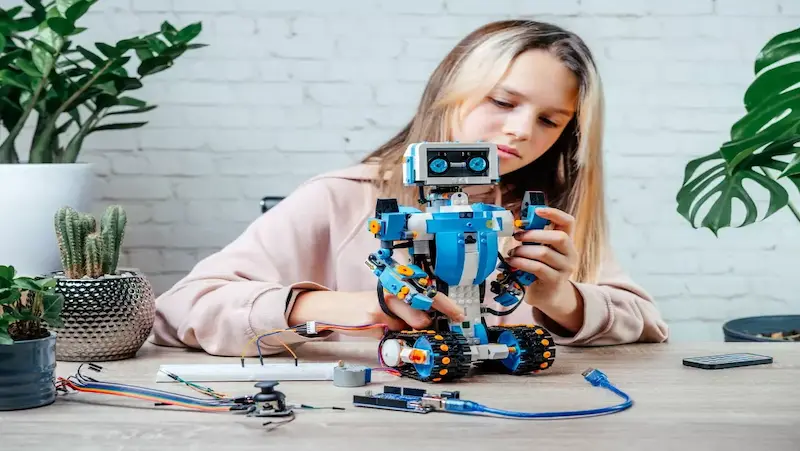Welcome to the world of Kids Learning Robotics, where innovation and imagination come together to ignite young minds. In this exciting journey, children will delve into the captivating realm of robotics, exploring the basics of technology, engineering, and programming while nurturing their creativity and problem-solving skills.
Join us as we embark on a captivating adventure that empowers young learners to build, program, and discover the wonders of robotics, paving the way for a future filled with endless possibilities.
Table of contents
Introducing Robotics to Kids: Getting Started
Robotics has captured the imaginations of both young and old alike, offering a fascinating blend of science, technology, and creativity. Introducing kids to robotics at a young age not only sparks their curiosity but also cultivates valuable skills that can benefit them in various aspects of life.

Choosing Age-Appropriate Robotics Kits
1. Age and Skill Level
Begin with kits designed for your child’s age and skill level. Look for kits with clear age recommendations to ensure that the complexity of the projects matches your child’s abilities.
2. Hands-On Activities
Opt for kits that offer hands-on building and programming experiences. Hands-on activities not only engage kids better but also promote critical thinking and problem-solving skills.
3. Programming Simplicity
Choose kits with user-friendly programming interfaces. Visual programming languages or drag-and-drop coding platforms can make learning to program robots more accessible and enjoyable for young beginners.
Creating a Suitable Learning Environment
1. Safe and Organized Space
Designate a safe and organized space for robotics activities. Ensure there’s ample room for building and experimenting, and that all necessary tools and materials are readily available.
2. Parental Involvement
Engage in the learning process alongside your child. Working together on robotics projects can strengthen your bond and provide valuable learning experiences for both of you.
3. Encourage Curiosity
Ask open-ended questions to stimulate curiosity and critical thinking. Encourage kids to explore, experiment, and ask questions as they work on their robotics projects.
Exploring Robotics with LEGO Mindstorms

Understanding LEGO Mindstorms Capabilities:
LEGO Mindstorms kits are not your ordinary LEGO sets. They are designed to introduce users to the fundamentals of robotics for kids by combining traditional LEGO building blocks with electronic components like motors, sensors, and a programmable brick.
Hands-on Building and Programming:
The heart of the Lego robotics for kids Mindstorms experience lies in the hands-on building and programming activities. Whether you’re constructing a robot that can navigate mazes, follow lines, or even solve puzzles, the process is both educational and entertaining.
Robotics and Future Careers

1. A Pathway to Imagination:
For kids who find themselves spellbound by the idea of robots that can think, move, and interact, the journey into the world of robotics begins with exploration. From assembling simple mechanical structures to coding intricate algorithms, the robotics camp nurtures creativity and ingenuity, offering a hands-on experience that fuels the imagination.
2. Exploring Career Avenues:
The fascination with robotics can lead to a plethora of future careers. As artificial intelligence, automation, and robotics continue to shape industries, the demand for skilled professionals is on the rise. Fields such as kids learning robotics engineering, software development, AI research, and even ethical robotics classes for kids consulting are becoming increasingly relevant, offering young enthusiasts ample opportunities to make a lasting impact.
3. The Future Job Market:
Robotics is not just about building machines; it’s about transforming industries. From healthcare and manufacturing to agriculture and entertainment, the integration of robotics is redefining how tasks are accomplished. This shift towards automation and innovation is creating a demand for individuals who possess a deep understanding of robotics and the ability to develop, program, and manage these cutting-edge technologies.
4. Building Essential Skills:
Beyond technical knowledge, a career in robotics equips youngsters with vital life skills. Problem-solving, critical thinking, teamwork, and adaptability are essential qualities that flourish in the world of robotics. The process of designing, building, and refining robots encourages a growth mindset, nurturing resilience in the face of challenges.
5. Fostering Ethical Considerations:
The influence of robotics extends beyond functionality. Kids interested in this field have the opportunity to shape the ethical landscape of technology. Discussions on AI ethics, robot-human interactions, and responsible AI implementation are becoming increasingly pivotal, allowing young minds to contribute meaningfully to the development of morally conscious technology.
Robotics and Artificial Intelligence
Imagine robots that can think, learn, and interact with the world just like humans. This magical blend of Robotics and AI is transforming how we live and work. At its core, Robotics involves designing, building, and programming physical machines to perform tasks, while AI empowers these machines with the ability to think and make decisions.

The Brainpower Behind the Machines
Artificial Intelligence acts as the brain of robots, enabling them to process information, learn from experiences, and adapt to new situations. Just like how you learn from your surroundings, AI-equipped robots gather data through sensors, process it using complex algorithms, and make smart decisions.
AI’s Impact on Robot Capabilities
For kids, the impact of AI on robots is like giving them superpowers. Robots can now see, hear, and even understand human language. They can analyze data to make predictions, play games, and even assist doctors in surgery. AI-driven robots are more than just machines; they are intelligent companions that can help in everyday life.
Interactive Learning with Robotic AI
Learning about Robotics and AI can be a thrilling adventure for kids. They can delve into coding to program robots, teaching them new tricks and tasks. By grasping the concept of AI, kids can witness the transformation of raw data into meaningful actions, making complex ideas easier to understand.
Unlocking Future Opportunities
As technology continues to evolve, the demand for skilled individuals who can work with both Robotics and AI is on the rise. By familiarizing themselves with these fields at a young age, kids can set themselves up for exciting opportunities in the future.
Overcoming Challenges in Robotics Learning

Complex Concepts:
Robotics involves intricate concepts like programming, engineering design, and electronics. These concepts might feel overwhelming at first, but remember, even the most skilled engineers started with the basics.
Technical Frustration:
Mistakes and technical glitches are a natural part of robotics. Instead of getting frustrated, view them as opportunities to learn. Debugging code or troubleshooting a circuit teaches problem-solving skills critical in robotics. Patience is key; perseverance will lead to breakthroughs.
Fear of Failure:
Fear of failure can hinder progress. Embrace failures as stepping stones toward success. Each unsuccessful attempt is a valuable lesson that brings you closer to your goal. Celebrate small wins, and remember that even the most innovative robots had their fair share of setbacks.
Lack of Resources:
Access to robotics kits for kids, components, or mentors might be limited. However, there are numerous online resources, virtual classes, and open-source platforms available. Don’t let a lack of physical resources hold you back—creative solutions can often yield remarkable results.
Overcoming Isolation:
Learning robotics can sometimes feel solitary, but it’s important to connect with fellow enthusiasts. Join online robotics for kids clubs, online forums, or social media groups to share ideas, ask for help, and celebrate achievements. Collaboration enhances learning and provides a sense of community.
Staying Motivated:
The initial excitement of learning robotics might fade over time. Set clear goals and break them down into achievable milestones. Reward yourself when you reach these milestones, and continuously challenge yourself with new projects to maintain enthusiasm.
Conclusion
In conclusion, “Unlocking the Future: Kids Learning Robotics for a Technological Adventure” empowers young minds to embark on a journey of discovery and innovation. By engaging in robotics courses for kids, children gain essential skills and insights that will shape the trajectory of our technological landscape.
This program not only nurtures creativity and problem-solving but also instills a profound sense of curiosity, preparing the next generation to confidently embrace the challenges and opportunities of the future.
Also, BrightChamps provides a comprehensive platform for learning about money for kids, offering interactive and engaging resources that teach financial literacy, budgeting, saving, and other essential money management skills.
Frequently Asked Questions
A1: It is an educational program designed to teach children about robotics and technology in an engaging and hands-on manner.
A2: The program is tailored for children typically aged 8 to 12, but can be adapted for slightly younger or older participants.
A3: Children will learn the basics of robotics, coding, and problem-solving through fun activities and projects. They’ll explore how technology shapes our world.
A4: No prior experience is required. The program caters to beginners and provides a solid foundation for kids new to robotics and technology.
A5: The program includes interactive workshops, hands-on projects, and collaborative activities, progressing from fundamental concepts to more advanced challenges.
A6: Experienced instructors, well-versed in robotics and education, will guide and mentor the participants throughout the program.
A7: Participants will require basic materials, which will be outlined before the program starts. These could include building kits and simple coding platforms.
A8: The program’s duration varies, but it often spans several weeks or months, with regular sessions to ensure comprehensive learning.


 We are an army of educators and passionate learners from BrightChamps family, committed to providing free learning resources to kids, parents & students.
We are an army of educators and passionate learners from BrightChamps family, committed to providing free learning resources to kids, parents & students.













